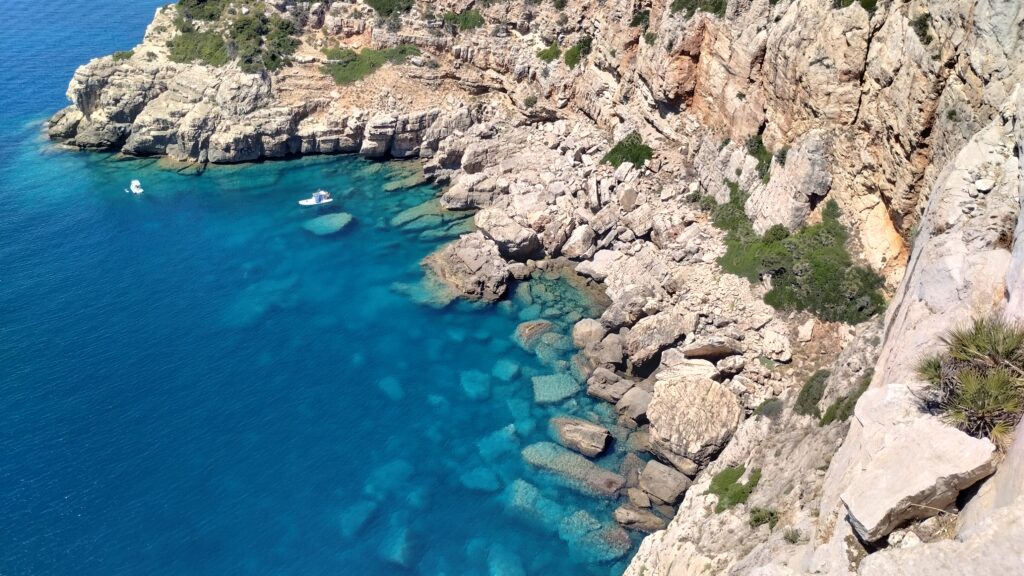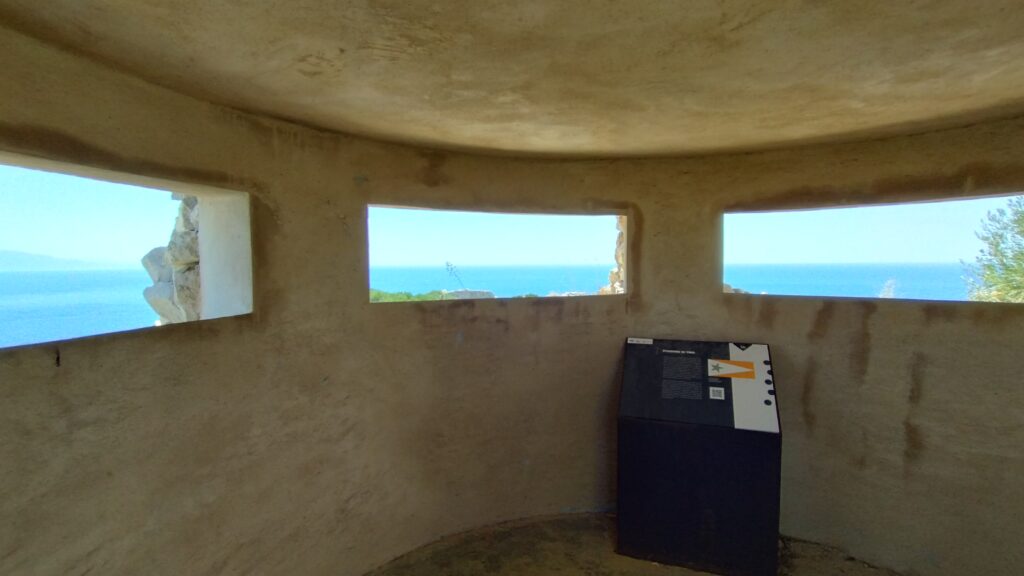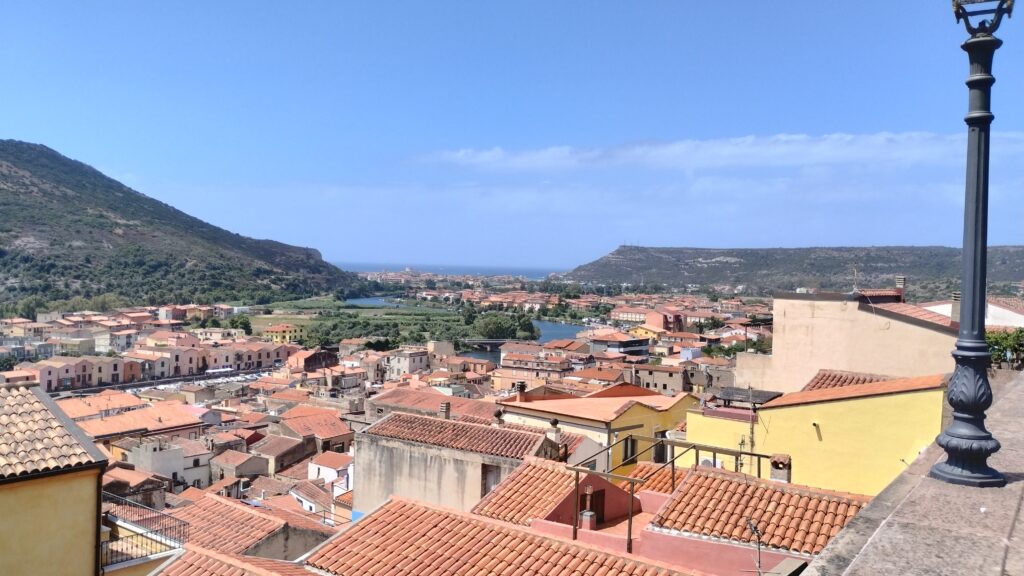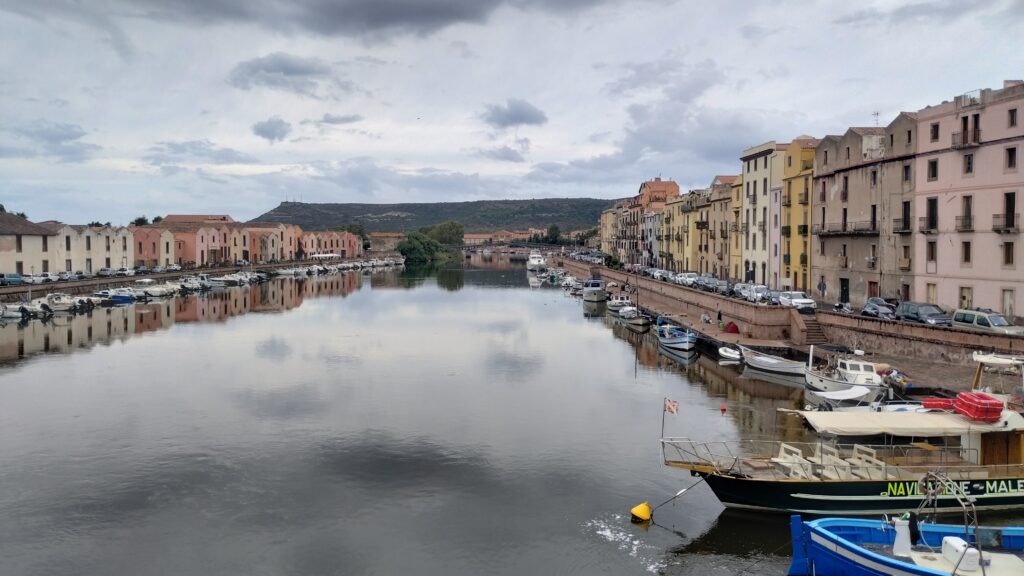Travels to Capo Caccia, Punto Giglio, Magomadas, and other fun trips on days off. This post is about exploring small towns and natural beauty in Sardinia.
Punto Giglio
Punto Giglio, like many other places along the Coast of Sardinia, is a cliff overlooking the sea. The hike to the top is incredibly long and hot. Sparse trees offer little shade and the steep path is lined with large chunks of inhospitable rocks. A small overpriced restaurant lies at the top, a long rectangular building with no distinguishable features. A short ways away from the cafe are old WW2 outpost ruins. Hidden in the rocks at the highest point are remnants of ammunition stores, watch towers, and several other war oriented buildings. The structure designs and materials keeps the interiors cool, covered in shade and relatively insulated from the sun above.
The views from the top are breathtaking. I walk to the edge of the cliff, overlooking the entire bay of Porto Conte. The land swoops downwards to touch the sea before rising to the even grander heights of Capo Caccia in the distance. Birds circle in the air over the ruins- showing off their freedom as they soar and swoop from one ledge to another before setting out across the water. Standing with my toes over the edge of the cliff I turn my gaze downwards to the crystal clear water below. The blue water is a brilliant turquoise in the shallows of the rocks before getting darker and deeper. The few boats that have anchored are barely the size of dimes. Sardinia truly has a natural beauty that is hard to find elsewhere. I am thankful that I am not scared of heights.
After soaking in the views, I begin the long journey downwards. The heat is unbearable. Luckily, the path eventually winds its way close enough to the sea for a quick swim. Amongst the crystal clear water are tiny fish and small shrimp that will nibble on you if you stay still long enough. The beach is made of small pebbles decorated with broken twigs from the nearby trees. Although it is a little beach, maybe 30 feet across, there are a few people here enjoying the sun and the water. Some boats are anchored just off shore, playing music and drinking. No one is stressed. Punto Giglio is just a nature reserve at the end of the day. The majority of the park is rocks, trees, and hiking, with the old ruins from the second world war slowly collapsing even with the parks’ upkeep; the soldiers stationed here were certainly the lucky ones. But now the echos of war are only reminders of a different time, completely unrelatable for the younger generations that come to walk the trails and see the ruins.











Magomadas / Bosa
Magomadas. A small town just outside Bosa. As with other towns in Sardinia the soft pastel houses nestle amongst the greenery and overgrowth of plants long forgotten to be pruned. I say town, but perhaps it is more of a village. This small village sits a top a hill overlooking a wide valley filled with farmland ranches. However it is not the jaw dropping natural views or the rustic forgotten Italian architecture that leaves the strongest impression on me during my visit: It is the unyielding, unapologetic, echoing silence.
It does not appear to be a ghost town as it is so quiet and so un interesting that even the spirits show no interest in staying here.
There are two types of silence; the one that is stifled, like a snow covered landscape or too much soundproofing in a house, and one that is echoing- Magomadas is the second. Sounds are not prevented from travel by any form of insulation, natural or unnatural. Sound simply does not exist for this village. The village exists inside a void. There simply isn’t any thing in the village that creates sound. No wind to rustle the leaves of potted plants. No birds or insects chirping as the entire mountaintop was paved long ago with cobble. No cars, air conditioners, or other motor powered machines to make the constant whirring noise we so readily dismiss into the background. No sounds of people going about their daily activities. If you were to approach this town while listening to music, or see it in pictures, it would strike you as normal on the surface. It is reminiscent of the small provincial town in Beauty in the beast. You know it is small, expect it to be limited in offerings of grocery store variety, and expect there to be a hustle and bustle of the towns people going about their daily lives. Tending to their plants, picking up food from the store, preparing to go to their jobs. There is none of this in Magomadas. Half of the buildings have signs in the windows for rent or sale. Every fourth building sits abandoned. If you look in from a photograph you would not know any of the buildings were abandoned as they share connecting walls to their inhabited brothers and their facades are kept up for appearances. Once you walk by you can see the cracks in their masquerade. The rustic wooden door is rotting where it touches the ground, and young plants spring up from the dirt inside. The shutters are missing a plank or two of wood, and inside the inset of the window you can see planks boarded over from the inside. A few even have their roofs missing entirely, with only the framework of a shell left to provide a sliver of shade to the trees growing within the once used rectangle of a house. And, permeating all of it, is the absolute lack of any sound. The silence.
As I walk down the cobble road my footsteps are the only thing I can hear echoing back. If I was told I was the last person on Earth, here, I would believe it. Devoid of any sound, caused by person nor nature, it is believable.
The cobblestones are rough and round stones that could fit in the palm of your hand inlaid in cement- old enough that most of the streets are in desperate need of repair with naturally forming pot holes where the stones have eroded and washed away. In the middle of the cobblestones are two lines of rectangular large stone, a standard width apart- perfect for car (or carriage) wheels.











Capo Caccia
Capo Caccia is one of the main cliffs that marks the border of the bay of Porto Conte. Its stony face rises high out of the sea, acting as a natural barrier to the harsh winds coming from the west. This makes a natural incredibly sheltered bay. Ships have been using this natural protected harbour for centuries to avoid storms and rough seas. It has a large two story lighthouse on top, and several ruins of Spanish towers from the 15th century. It is easily accesible by road and is a popular spot to watch the sunset over the ocean from the land. The terrain is rocky with a variety of local dry-weather plants covered in thorns to survive the harsh environment. If you know where to look, there are even small shallow caves along the cliff side.
It was here I had the opportunity to go rock climbing for the first time. There is a set rock climbing trail made in the side of the cliff: harnesses mandatory. Steel cables are secured as both hand holds and safety lines while traversing places with limited foot holds and in other places you are literally clinging to the sheer cliff side holding onto only a single piece of mounted rope to keep from falling off. Pieces of Rebar are adjoined in the form of footsteps/handholds in the more difficult places. There’s something about the feeling of standing on a single piece of rebar sticking out of a cliff, with nothing except the sea hundreds of feet below. Nothing to catch your fall. Nothing to hold on to. Trusting solely in the engineering of man, and trusting the men who you’d never met nor heard of have successfully meshed metal into rock. That the trail is maintened and up to standards. That nothing is loose and will give way beneath your weight. I am very thankful I am not afraid of heights. I love the views they provide. Standing on the side of a cliff which is hard to access, not running into any other people, offers a side of solitude that is hard to find elsewhere. Comforting yet lonely. The accomplishments of man used simply to make nature more accessible. The millions of people who had seen the same view- where were they now?
At the end of the trail ‘Via Ferrata’ (If I recall correctly) There is a guestbook in a metal box for other like minded souls to sign and leave messages. While most are in English a wide variety of other languages are present as well. Mostly traversed by tourists instead of locals. It was fun.



Little Lighthouse
On sweltering days off the crew would take out the dinghy- the RIB we bring along on daily excursions with Andrea Jensen. The dinghy is about 12 feet long with inflatable sides and a hard sheet of plastic connecting them and forming the bottom of the boat. The engine is controlled from a metal and plastic box that sticks up from the floor towards the back. As today was a day off, and hot as hell, we all piled in the dinghy and set off towards cool clear water. A short distance away from the marina is a shallow area. Since the water is so shallow here it is perfect for anchoring and going for a swim- very popular amongst the local boats. Especially on hot days like these. On one side is the beach in the distance, polkadotted with colorful beach umbrellas and lined with popular beach bars in the background. To the other side there is a small cluster of rocks rising out of the shallow water and topped with a small lighthouse and overturned boat. The boat is small and white and lays on its side. It’s been there at least a decade and acts as a warning to overconfident sailors on the dangers of the shallows. The small ‘island’ itself is picturesque with small stone steps leading up the rocks to the lighthouse, about 2 feet above the waves.
The water is pure turquoise here since the shallowness allows the blue of the water to be reflected by the rocky bottom. Fish swim just below your feet- only slightly out of reach but confident they are outside your zone of control. The coolness of the water is refreshing on a day easily over 110 degrees. As I get out of the water and lay in the sun to dry off I wipe away the lines of condensed salt that ring around the edges of my face and shoulders. My host family hands me a beer while I enjoy the scenery. There is truly no better way to spend such a hot day than swimming in the sea and drinking.
On the way back to the main ship Colin decides to drive. As soon as the anchor is up and away he absolutely floors it at max throttle. My right hand is death gripping the metal pole from the control consol with white knuckles as my left hand clings to my half finished beer. I immediately brace as I feel all my weight yanked backwards and thrown into my arm. I have a split second to think about my big straw hat before it is whipped backward, caught only by the cord around my neck as it flutters violently in the wind. Sitting on the towel, my body begins to slide from the side of the boat along the inflatable tube and it becomes increasingly apparent that that my right arm is the only thing keeping me attached, lest I be flung from the boat with as much force as my hat. It is truly the only way to spend hot summer days.

Neptune’s Caves
There were a lot of rocks to see!











